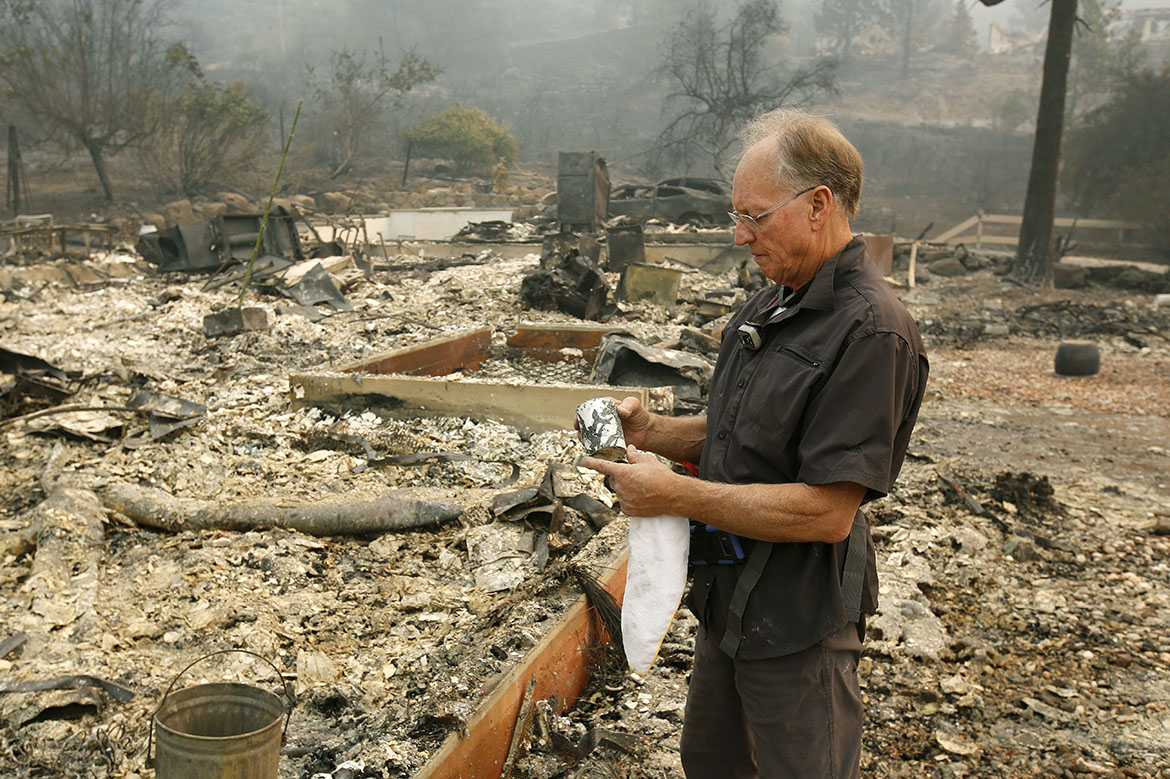They were asleep when the fire reached their home. Charles Rippey, 100, and his wife, Sara, 98, had been married 75 years. They died together, after a caregiver struggled to save them but couldn’t get them out in time.
A 27-year-old woman had spina bifida and used a wheelchair. In the hours after the fires broke out, her relatives frantically sought information about her whereabouts. When a fire inspector visited her home, he found her body.
Wildfires continue to spread through Northern California counties, already taking the lives of at least 31 people. Hundreds more are missing. Local officials and advocates fear that many among them are seniors or disabled people unable to flee, as many residents have, on a moment’s notice.
Others have been saved only by luck and quick-thinking neighbors.
In Mendocino County’s Redwood Valley community, retired firefighter RedHawk Palleson came across a disoriented elderly woman wandering in his neighborhood and an older couple in their bathrobes as flames chased them down the street, the Santa Rosa Press Democrat reported. He drove them to safety in his truck.
The deaths and close calls illustrate the particular vulnerability of frail people living on their own during a fast-moving disaster. “The fires have raised a lot of questions about how we respond and provide safety to vulnerable people in an imminent crisis,” said Marty Omoto, executive director of the California Disability Community Action Network. “We have to ask ourselves how we respond when there’s no warning.”
Omoto said he is still trying to reach friends and colleagues living with disabilities in the region. “We’re operating on hope,” he said.
In both Sonoma and Napa conties, where the wildfires have been the most severe, about 18 percent of residents are age 65 or older, higher than the statewide percentage of 13.6 percent, according to U.S. Census data. About 6 to 8 percent of those counties’ residents have disabilities.
This week, people posted poignant queries on social media hoping to find loved ones still missing. “Has anyone seen the woman on the right?” Elizabeth Northrup wrote on Facebook, providing a picture of an older woman. “Her name is Norma Lou Peoples. She uses a red walker.”
Nursing homes aren’t fail-safe, as was tragically illustrated by the eight deaths in a sweltering Florida nursing home left without air conditioning after Hurricane Irma. But they, along with assisted living facilities and homes for the disabled, do have disaster and evacuation plans. In-home caregivers rarely get training on how to help their clients in an emergency, Omoto said, and in a disaster they may have their own families to care for. And of course some frail people don’t receive in-home care.
Marianne McBride, president and CEO of Sonoma County’s Council on Aging, said Wednesday that she and her staff were still trying to track down the agency’s social services clients, including up to 1,200 who regularly receive “meals on wheels.”
It was a challenge. Over the weekend, cellphones either didn’t work or worked only sporadically as the fire destroyed 73 cellphone towers. Internet and electricity were down in some areas. But by Monday, the agency had reached 600 seniors, McBride said.
McBride, whose brother lost his home in the fires, said seniors or disabled people should consider keeping their landlines rather than relying only on cellphones. She also said social service providers should keep paper copies of client locations as a backup when internet and electrical services fail.
McBride also recommended that family members get acquainted with the neighbors of their elderly relatives and provide them with their contact information in case of emergency. Neighbors have to look out for each other, she said.
“There’s not a service agency that can take care of all the aging individuals that we have in the community,” McBride said, choking back tears. “What the fires bring out is that the only way we’re going to successfully age is if we do so in community, and the community feels it has a responsibility to look out for neighbors and get them the resources they need.”
As developmentally disabled people increasingly live independently, they too need support both during and after disasters.
Vicki Smith, a deputy director at the California State Council on Developmental Disabilities, said the public agency in the past year has trained more than 1,100 developmentally disabled people in disaster preparedness with simplified materials, including how to assemble an inexpensive emergency backpack. She estimated that there are more than 10,000 developmentally disabled people living in Sonoma and Napa counties.
Disaster experts say the general preparedness recommendations for everyone are even more important for people with limited mobility. For instance, keep the car gassed up and put a change of clothes and an emergency kit in the trunk. And sign up for your community’s alert system (although there were some complaints from Northern California residents that they never received these alerts).
Nancy McPherson, state director for AARP California, urged people to learn ahead of time the routes to buildings likely to be used as shelters during an emergency, such as a local high school.
McPherson said the AARP has partnered with the Federal Emergency Management Agency in the past, but this year’s severe hurricanes and fires have sparked a new effort to make emergency preparedness for seniors “more robust,” she said.
Some communities have tried to develop registries of elderly and disabled people who might need rescue in emergencies, but such registries are difficult to keep current, McPherson said.
“There’s been a lot of thinking about this, but plans get put on a shelf and we tend to forget that they are there,” McPherson said.
This story was produced by Kaiser Health News, which publishes California Healthline, an editorially independent service of the California Health Care Foundation.
KFF Health News’ coverage of aging and long-term care issues is supported in part by The SCAN Foundation.
